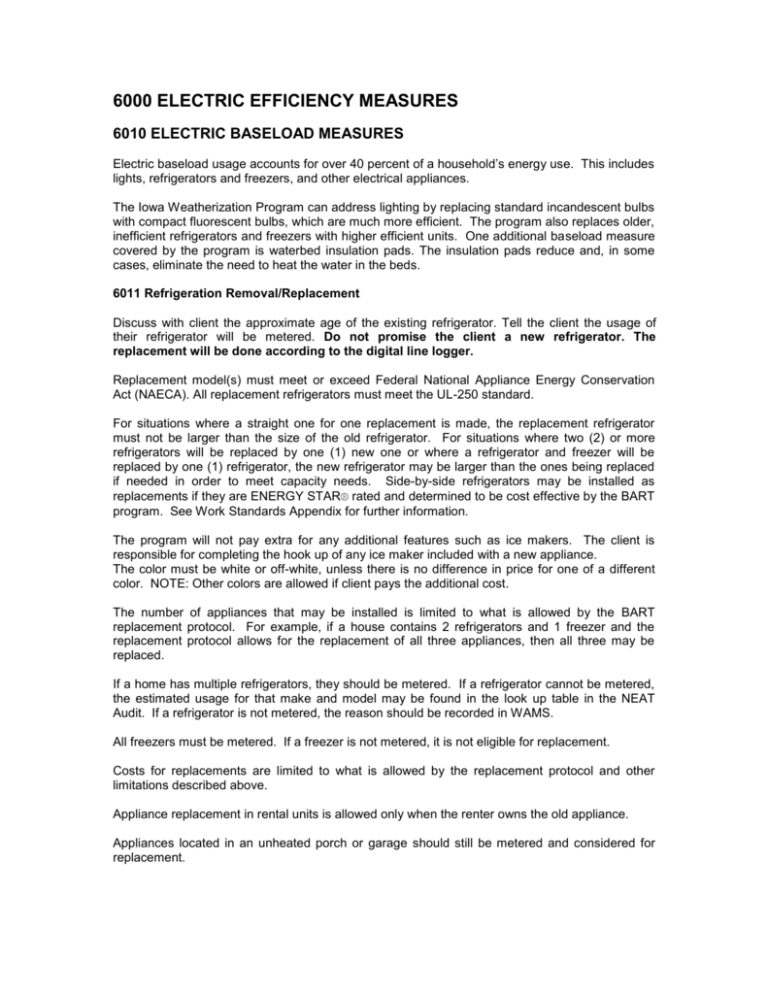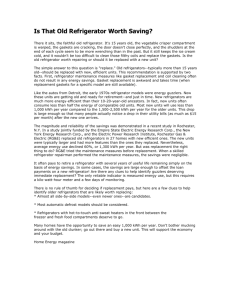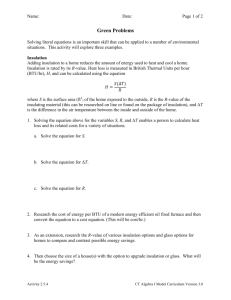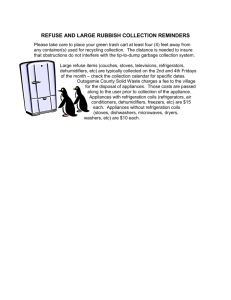6000 ELECTRIC EFFICIENCY MEASURES
advertisement

6000 ELECTRIC EFFICIENCY MEASURES 6010 ELECTRIC BASELOAD MEASURES Electric baseload usage accounts for over 40 percent of a household’s energy use. This includes lights, refrigerators and freezers, and other electrical appliances. The Iowa Weatherization Program can address lighting by replacing standard incandescent bulbs with compact fluorescent bulbs, which are much more efficient. The program also replaces older, inefficient refrigerators and freezers with higher efficient units. One additional baseload measure covered by the program is waterbed insulation pads. The insulation pads reduce and, in some cases, eliminate the need to heat the water in the beds. 6011 Refrigeration Removal/Replacement Discuss with client the approximate age of the existing refrigerator. Tell the client the usage of their refrigerator will be metered. Do not promise the client a new refrigerator. The replacement will be done according to the digital line logger. Replacement model(s) must meet or exceed Federal National Appliance Energy Conservation Act (NAECA). All replacement refrigerators must meet the UL-250 standard. For situations where a straight one for one replacement is made, the replacement refrigerator must not be larger than the size of the old refrigerator. For situations where two (2) or more refrigerators will be replaced by one (1) new one or where a refrigerator and freezer will be replaced by one (1) refrigerator, the new refrigerator may be larger than the ones being replaced if needed in order to meet capacity needs. Side-by-side refrigerators may be installed as replacements if they are ENERGY STAR® rated and determined to be cost effective by the BART program. See Work Standards Appendix for further information. The program will not pay extra for any additional features such as ice makers. The client is responsible for completing the hook up of any ice maker included with a new appliance. The color must be white or off-white, unless there is no difference in price for one of a different color. NOTE: Other colors are allowed if client pays the additional cost. The number of appliances that may be installed is limited to what is allowed by the BART replacement protocol. For example, if a house contains 2 refrigerators and 1 freezer and the replacement protocol allows for the replacement of all three appliances, then all three may be replaced. If a home has multiple refrigerators, they should be metered. If a refrigerator cannot be metered, the estimated usage for that make and model may be found in the look up table in the NEAT Audit. If a refrigerator is not metered, the reason should be recorded in WAMS. All freezers must be metered. If a freezer is not metered, it is not eligible for replacement. Costs for replacements are limited to what is allowed by the replacement protocol and other limitations described above. Appliance replacement in rental units is allowed only when the renter owns the old appliance. Appliances located in an unheated porch or garage should still be metered and considered for replacement. Removal and proper disposal of all replaced appliances is required. The appliances must be disposed of according to the environmental standards in the Clean Air Act (1990), Section 608, as amended by Final Rule, 40 CFR 82, May 14, 1993. Appliance repair is not allowed. The replacement policies and guidance cannot cover all possible situations. In some cases, common sense must be used to determine whether an appliance replacement is appropriate. For example, if a household has a second refrigerator that is seldom used or is used to store very little, it would not make sense to replace it with a new appliance. Instead, efforts should be made to encourage the client to allow the straight removal of the appliance. Install a digital power meter to the refrigerator. Caution: If the refrigerator is running when ready to install the power meter, allow refrigerator to sit for a minimum of five (5) minutes before plugging into the Digital line logger. This will allow compressor pressure to be relieved. The time the logger is plugged in should be recorded. The appliance(s) must be metered for a minimum of 120 minutes (2 hours). Record the kWh usage and the number of minutes from the Digital Line Logger on the evaluation forms or on the client agreement form. This information is needed because it will be entered later in the WAM’S material database. Use the TI-86 calculator to determine the annual energy consumption by each appliance. The Annual Energy Consumption Conversion Table (Conversion Table) may also be used to convert short-term metering results to an annual energy consumption amount. The short-term metering results are based on the duration of the metering and the meter reading. The annual consumption is shown on the Conversion Table, rounded to the nearest 100kWh. The table lists short-term kWh readings down the left side and minutes that the appliance was metered on the top. Example: If a refrigerator is metered for 120 minutes (2 hours) and the Digital Line Logger showed it used .43 kWh, the annual usage from the conversion table would show the annual usage of the refrigerator at 1900 kWh. Once the annual energy consumption of the existing appliance(s) has been determined using the TI-86 or the Conversion Table, the evaluator can determine if it is cost effective to replace the existing appliance(s). This is done by comparing the annual energy consumption of the existing appliance(s) with the replacement ratings of the “new” appliances. The replacement ratings of “new” appliances are found on the Replacement Ratings Report, which is produced by the BART program (see BART Manual in the Work Standards Appendix). The evaluator reviews the replacement ratings for the appliances listed on the Ratings Report to see which appliances have a rating less than the annual energy consumption of the existing appliances. Any appliance or combination of appliances may be installed as long as the replacement rating of an appliance or total replacement rating of any combination of appliances is less than the total energy consumption of the existing unit or combination of existing units. Example: Bart Rating Table ID R1 R2 R3 Rating 1160 1140 1300 Brand Whirlpool Amana Frigidaire Style TF TF BF Size 14 16 18 R4 1250 Kenmore TF 16 The client has two appliances. The two units were metered for 2 hours, and showed consumption of 0.252 and 0.180. We extrapolate these values to annual consumption rates using the TI-86 or the Conversion Table and find the rates of 1,104 kWh and 788 kWh, respectively. The total annual energy consumption of these two units is 1,892 (1,104 + 788). In this example, the replacement refrigerators cannot be exchanged for either of the existing units since the replacement ratings of the replacement refrigerators exceed the annual energy consumption of each of the existing units (1,104 and 788). However, a replacement refrigerator can be installed if both of the existing units are removed because the replacement rating of any of the refrigerators listed is less than the total annual energy consumption of the existing units (1,892). When determining which new appliances can be installed, ensure the new appliance will fit into the space available and hinged on the correct side. Once it is determined whether the replacement appliance or a combination of appliances is costeffective, discuss the possibility with the client. It may be possible to propose the replacement of multiple appliances for one new appliance. Greater energy savings are realized if multiple appliances can be replaced with one (1) appliance. If the client agrees to a replacement of an appliance or a combination of appliances, complete the Client Agreement Form and have the client sign the form. The Client Agreement Form lists the existing appliances that will be replaced and the new appliances that will be installed. The form will be printed on two-part NCR paper so one (1) copy can be given to the client and one (1) copy kept by the agency. 6012 Fluorescent Lighting Fluorescent lighting is one of the most cost-effective measures that can be installed. Fluorescent bulbs use from 50 to 75 percent less electricity than incandescent bulbs and last 8 to 10 times longer. Incandescent light bulbs can be replaced with compact fluorescent light bulbs if they will be used an average of three (3) hours per day. A maximum of 12 bulbs may be installed in each house. All compact fluorescent bulbs installed must be ENERGY STAR® rated with a color temperature of 2700K and color rendering index of 84. Compact fluorescent bulbs may be installed with client permission in each house. If the bulbs are not to be installed as a secondary utility funded measure, the bulbs must be included in the NEAT Audit data with a SIR of greater than one. Fluorescent bulbs can have a lower wattage than incandescent bulbs and still provide the same light output. Table 1 shows the bulb wattage that should be selected when replacing incandescent bulbs with compact fluorescent bulbs. Table 1 Incandescent 100 w 75 w 60 w 40 w 25 w Compact Fluorescent 23 w 18 w 15 w 11 w 9w 6013 Waterbed Insulation Pads Waterbed mattress pads do not need to be installed; they just need to be left at the home if the client agrees to install them. The NEAT Audit does not need to be used to determine the cost effectiveness of the waterbed insulation pads. Density must be 2.0 – 2.4 lbs per cubic foot. Must meet fire code CS – 117.







